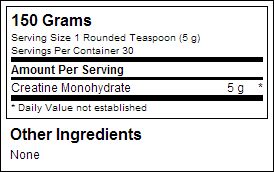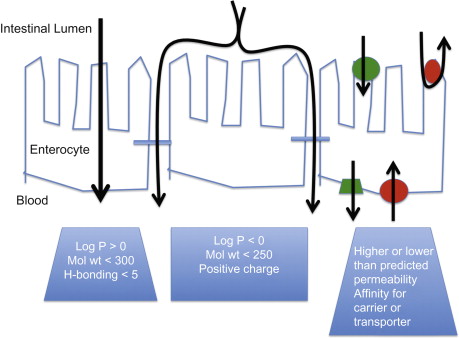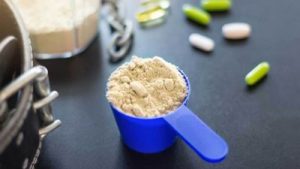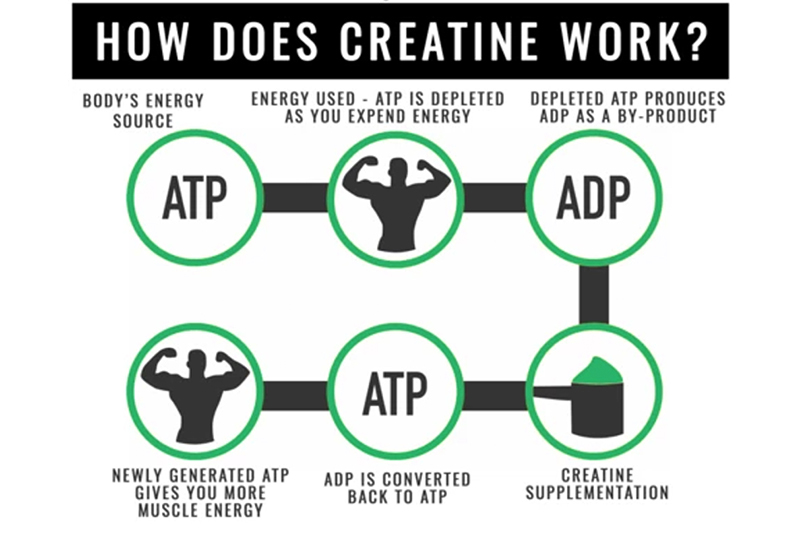If you ask “how much creatine should I take?” Invariably the answer given is 5 grams as a typical creatine dosage.
But did you know it’s WRONG? (it’s generally acceptable but technically incorrect)
Have You Ever Heard of the Creatine Dosage of 5 grams?
I’m sure you have as it’s the most common recommended serving size given verbally and on almost every single brand of creatine monohydrate you can purchase.
Dosage is commonly between 2-25 grams a day (5 grams is an average recommended amount) depending on your body weight, the stage you are in, and any special circumstances.
Read the comment section on the dosage argument HERE !
A Typical Recommended Creatine Dosage is 5 grams.
But did you know that is true for a 367 lb person?. You can use a lot less creatine and get results. Learn how to find the right creatine dosage for you based on your body weight.
The more muscle mass you have, the greater the requirement for creatine supplements.
The information below is not the typical dosage that you see on almost any website or product.
To date, there have been no negative effects reported by such a higher dosage so there’s no real reason to change it.
Keep in mind that almost every study to date has not measured the long-term effects of a 5 gram a day creatine dosage.
It’s just nobody has any negative consequences yet after 15 or more years of being on the market so it’s generally accepted as safe.
Table of Contents
Why Almost Everybody Says 5 Grams of Creatine per Day
The 5-gram daily maintenance dose that every company says to take and almost every fitness professional asked will tell you if the daily dosage is wrong.

But the real reason nobody is going to change it is that it’s too difficult to re-educate the consumer and if you recommend such a dosage, it’s going to work for 99% of the population that would take it and respond to creatine.
Hence, the shotgun approach to supplementation.
So how much creatine can your body absorb?

Image credit: https://www.sciencedirect.com/science/article/pii/B9780123964540000400
The bottom line, it depends on your overall body weight which determines your maintenance dosage. A person who’s 250 lbs will require more than a person who is 130 lbs to maintain muscle saturation (the ultimate goal of creatine supplementation).
Once you’ve reached the saturation point, if the muscle can’t hold anymore, it won’t keep it and will flush out any excess creatine. Look at the table below to find your perfect dosage based on your body weight. Any more and you are wasting the product. Too much and it can technically be dangerous.
.
The Drawbacks to an Improper Creatine Dosage
Unused (not absorbed excess creatine) ends up in the toilet. It puts stress on the kidneys and other filtering organs to eliminate it. It’s a waste of products.
So if you really only need 2.5 g a day dosage based on body weight but all the labels tell you to take 5 grams, you are wasting 2.5 grams and putting a small bit of unnecessary stress on your body. It’s worth the effort to get it right rather.
Unlike protein where 1g per 1 lb of body weight is actually pretty accurate, 5 g. per day for everybody is well off the mark.
An overconsumption:
-
- reduces the efficiency of creatine absorption by muscle,
- over-supplementation is (athletically) futile,
- (physiologically) stressful and
- (economically) wasteful
Creatine Loading Phase
Players can choose to lose one Rep Movement speed and one Aim Point to gain two more Ability Power, increase Rep Turnover to two every second, and no longer lose their speed. Legacy according to International society of sports: Accelerated Reactions. Reduces the cooldown of Adrenaline Rush by three seconds. This is pretty much right in the sweet spot for a Support to be able to, based on everything I’ve outlined for Support Performance and Rep Turnover. Adrenaline Rush also grants the Ability Power buff, which most Support players can have in their deck. It’s not super-important to have this one in your arsenal because it’s a pretty small nerf to your ability, and just because it isn’t the most useful of buffs doesn’t mean it doesn’t have value.
If it were much bigger, it would go a long way to making a Support perform more. Intellect-Only Ancestral Healing. Gives Tassadar a longer duration Healing Surge buff while below 20% HP. These are pretty handy for some stats-focused Supports, and a portion of their abilities usually turn the corner at low HP, so having a quicker Tassadar heals them well.
Safe Creatine Dosage for Seniors
Seniors who have previously worked out their liver to keep the body alkaline can be at a higher risk for taking too much of the wrong creatine supplement. It may happen due to sudden health care concerns or the medications. In these circumstances, it is best to make an actual conversation with the physician regarding the amount of creatine that you are allowed to take.
Senior athletes do have a shorter metabolism as well as elevated kidney function. However, your creatine level has to be fine. Otherwise, it can cause physical damage. Exercise performance Plus Creatine Supplement for a high-intensity workout. By finding safe creatine supplements that are beneficial, exercise scientists can also minimize injuries. Remember that the appropriate dosage of creatine is required for proper performance.
First, it’s important to mention you do not need to load creatine for it to be effective.
This creatine loading phase is optional. Almost every study done starts off with the loading phase.
 This is a quick way to get your muscles saturated with creatine. It’s important to note that your body can only absorb so much at one time. 5 grams is correct for the average-sized male.
This is a quick way to get your muscles saturated with creatine. It’s important to note that your body can only absorb so much at one time. 5 grams is correct for the average-sized male.
So there’s no need to take too much at one time during the loading phase.
The idea is to split up the dosage during the day. You get the muscles to the saturation point much faster and you start receiving the benefits quicker.
How Long is the Loading Phase
If you use the loading period, in about 5 days give or take a day, your muscles are at full capacity.
At which point, they can be maintained with just a few grams a day.
The stage after the loading period is called the maintenance phase. You can skip the loading period and just start with a maintenance phase and still derive the full benefits of creatine supplementation.
Creatine Dosage for Weight Lifting
Is A Higher Solution All You Need by medical advice? In recent years, there has been a surge in the number of people using creatine, for a variety of reasons. The primary one being that it’s one of the fastest-growing supplements in the US, seeing an explosion in sales, particularly amongst bodybuilders and powerlifters. However, the surge in the popularity of creatine has also seen the popularity of much more advanced powders, which use a much higher dosage than traditional brands. Are they effective? First of all, it’s worth highlighting that It has been around for a long time, albeit as a research tool, before being moved into consumer products for exercise performance.
And it is that research that’s behind much of the marketing for some of these so-called “pure” products. Such supplements are often promoted as containing no fillers, hormones, or other substances that people associate with steroids or other types of performance-enhancing drugs. However, while we cannot verify the lack of those things in those supplements, we can look at the amount of creatine in the product. The reason for this is that monohydrate, or CHM, is used to build muscle by binding to proteins in the body that are critical for muscle protein synthesis. When this occurs, muscles grow. So by increasing the amount of monohydrate in the body, you can ensure that the muscle cells are receiving an adequate amount of the compound. Therefore, can be seen as the amount needed for the desired effect. With that said, it is also important to note that when you increase the dosage, you also increase the amount converted to creatine phosphate (which is the active form of the compound), which impacts performance. This article does not examine the benefits and side effects of the loading phase before resistance training. For example, if you take a dose of 1 gram, it will be broken down to creatine phosphate in your bloodstream.
Is the Loading Phase Really Necessary?
To load or not to load, is a matter of personal decision and your tolerance to higher levels initially. On one hand, the loading phase will aid in results happening quicker.
On the other hand, if you omit the loading period you will put less stress on the kidneys (renal) and reduce overall stress on your filtering organs. Most of the stomach discomfort people report is their intolerance to high creatine levels.
Skipping the loading period can help with that situation. Because of the increased susceptibility of older people to kidney dysfunction, anyone over 70 years of age is strongly encouraged to skip the loading phase.
If you skip the loading period, a dose of 0.045 g. per kilogram of body weight is recommended for 4- 5 weeks before incorporating the washout phase explained below.
.
The Maintenance Phase Explained
You can take just a few grams per day and in about 20 training days or so, you’ll be at maximum levels. The dose only needs to cover the amount of loss per day.
This phase lasts about 3 to 5 weeks before taking a break from creatine sports nutrition called the Washout Phase.
How Do You Calculate Your Personal Creatine Dosage
The loading, phase takes 0.3 g. for each kilogram that you weigh. Reduce the dosage to 0.03 g. per kilogram of body weight during the maintenance phase; 10-times less.
Daily creatine dose according to body weight:
| Weight | |||||||||||
|---|---|---|---|---|---|---|---|---|---|---|---|
| Pounds | 100 | 110 | 120 | 130 | 140 | 150 | 160 | 170 | 180 | 190 | 200 |
| Kilograms | 45.4 | 50 | 54.5 | 59 | 63.6 | 68.1 | 72.7 | 77.2 | 81.8 | 86.3 | 90.9 |
| Dose (grams) | |||||||||||
| Loading | 13.6 | 15 | 16.3 | 17.7 | 19 | 20.4 | 21.8 | 23.1 | 24.5 | 25.9 | 27.2 |
| Maintenance | 1.36 | 1.5 | 1.63 | 1.77 | 1.9 | 2.04 | 2.18 | 2.31 | 2.45 | 2.59 | 2.72 |
This table gives doses during the loading and maintenance phases of supplementation for a range of body weights.
It is rather insoluble. Five grams requires at least 13 ounces (385 mLs) of liquid to go completely into the solution. Therefore, mix your creatine in at least 13-16 ounces (474 mLs) of liquid.
Bloating is particularly common during the creatine loading phase and may occur because creatine draws water into the cells of the muscles, causing water retention.
What is Creatine Nitrate?
Creatine is a naturally occurring compound found in all muscle tissues. When the body doesn’t receive enough of this nutrient, the muscle fiber becomes smaller and weaker, making the individual weaker and smaller than he or she could possibly be. Well-developed muscles are composed of many muscle fibers of the same size and strength, so if you’re deficient in the quantity of creatine, you’re going to have a lot of muscle that is very weak. How Does Creatine Nitrate Work as pre workout or post workout?
Creatine nitrate is injected into your bloodstream and binds with the myoglobin in your muscles. This vegan protein helps the muscle fiber remain active, and creatine works to make the myoglobin more soluble so that the muscle can use the creatine faster. Why Do I Need Creatine Nitrate with amino acids? When you train, your body’s glycogen stores are depleted (this is when muscle glycogen breaks down into glucose).
When is the Best Time to Take Creatine
Take one part of your loading dose and your entire maintenance dose immediately after exercise. Include carbohydrates and protein in these meals. If you aren’t doing the loading period, then just take your calculated dosage.
Do You Need to Take Creatine Every Day?
Your creatine stores won’t empty in a day or two if you miss a daily dose. It takes about a month for your stores to return to normal.
The Washout Phase – When to Stop Taking Creatine
After 4-6 weeks of supplementation, stop taking. This allows your body to recover and return to normal levels. This phase lasts for about 1 month. Some research has shown that levels drop in muscle even with continual supplementation. This is reason alone to stop using creatine for a short period so that the effects and levels and results can be achieved again.
This is a good little summary of creatine monohydrate by About.com
Questions? Comments? Tried Creatine yet? What are your results? Thoughts? Share!
.
Frequently Asked Questions
How Much Creatine Per Day to Build Muscle?
To build muscle, the recommended daily dosage of creatine varies depending on factors such as body weight and individual response. Generally, a loading phase of 20 grams per day for the first week is suggested, divided into four 5-gram doses. This initial phase aims to saturate the muscles with creatine. Following the loading phase, a maintenance dose of 3-5 grams per day is typically recommended. However, individual tolerance and response should be taken into account.
It is important to note that these recommendations are based on scientific studies conducted on healthy individuals. Research suggests that creatine supplementation can enhance muscle strength and power by increasing phosphocreatine stores in the muscle, which aids in the production of adenosine triphosphate (ATP), the primary source of energy for muscle contractions. Additionally, creatine has been shown to increase muscle protein synthesis, leading to greater muscle growth.
While creatine is generally safe for most people, it is crucial to stay adequately hydrated when supplementing with creatine, as it can cause an increase in water content within the muscles. Furthermore, it is advisable to consult with a healthcare professional or a registered dietitian to determine the optimal dosage for your specific needs and goals.
Moreover, it is worth noting that individual responses to creatine supplementation may vary. Some individuals may experience significant benefits from creatine, while others may see minimal effects. Factors such as training regimen, diet, genetics, and overall health can influence individual responses.
How to Take Creatine Monohydrate?
To effectively take creatine monohydrate, it is important to follow specific guidelines to maximize its benefits. The most common method is known as “loading” followed by a “maintenance” phase. During the loading phase, it is recommended to consume 20 grams of creatine monohydrate per day for the first week. This can be divided into four 5-gram doses taken throughout the day to saturate the muscles with creatine.
To enhance absorption, it is advisable to consume creatine monohydrate with a source of carbohydrates or a high-glycemic index beverage, as insulin secretion can facilitate creatine uptake by the muscles. Examples include mixing creatine with fruit juice or a sports drink.
After the initial loading phase, a maintenance dose of 3-5 grams per day is typically recommended to sustain elevated creatine levels in the muscles. This maintenance phase can be continued for an extended period, as long-term creatine supplementation has shown to be safe and effective.
It is important to note that creatine monohydrate should be dissolved in water or a suitable beverage, as it may not dissolve completely. Stirring or shaking the mixture can help facilitate dissolution. It is also crucial to stay adequately hydrated while taking creatine, as it can cause an increase in water content within the muscles.
To ensure optimal results, it is advisable to consult with a healthcare professional or a registered dietitian before starting creatine supplementation. They can provide personalized recommendations based on individual factors such as body weight, training goals, and overall health.
In summary, when taking creatine monohydrate, a loading phase of 20 grams per day for the first week, divided into four 5-gram doses, followed by a maintenance phase of 3-5 grams per day is commonly recommended. It is important to dissolve creatine in water or a suitable beverage, consume it with a source of carbohydrates, and stay adequately hydrated. Consulting with a healthcare professional is advised for personalized guidance.
Can You Take Too Much Creatine?
Research indicates that, for most individuals, a daily creatine intake of around 3 to 5 grams is sufficient to saturate muscle stores over time. However, some may be tempted to engage in a “loading phase” where higher doses, often 20 grams per day, are consumed for a week to expedite saturation. While this approach is generally safe, it may cause gastrointestinal discomfort in some individuals.
It’s important to emphasize that excessive creatine intake beyond recommended levels does not provide additional benefits. The excess creatine not utilized by the muscles may be converted into creatinine, a waste product excreted by the kidneys. Prolonged elevation of creatinine levels due to excessive creatine intake could potentially strain the kidneys, particularly in individuals with pre-existing kidney conditions.
Moreover, dehydration is a concern associated with high creatine intake. Creatine draws water into the muscles, and inadequate hydration may lead to cramping and heat-related issues, especially during intense physical activity.
Individual responses to creatine vary, and certain populations, such as those with kidney dysfunction, should exercise caution and consult healthcare professionals before starting supplementation. Monitoring kidney function through regular check-ups is advisable for individuals with existing renal conditions.
In conclusion, while creatine is generally safe and effective within recommended dosages, exceeding these levels may pose potential risks, including gastrointestinal discomfort, kidney strain, and dehydration. Adhering to recommended guidelines, staying adequately hydrated, and consulting with healthcare professionals, especially for individuals with pre-existing conditions, ensures a balanced and safe approach to creatine supplementation.
Timing, Optimal Dose and Intake Duration of Dietary…
When incorporating dietary supplements into your routine, the timing, dose, and duration of intake are crucial factors that can significantly influence their effectiveness. Here’s a comprehensive guide based on current scientific understanding:
Timing
The optimal timing of supplement intake can enhance absorption and efficacy. For instance, fat-soluble vitamins (A, D, E, K) are best taken with meals containing dietary fat, as fat enhances their absorption. Water-soluble vitamins (C, B-complex) can be taken on an empty stomach to maximize uptake. Minerals such as magnesium and calcium are often best taken in the evening, as they can aid in relaxation and improve sleep quality. Conversely, caffeine-containing supplements or those that boost energy should be consumed earlier in the day to avoid sleep disturbances.
Optimal Dose
Determining the right dose is essential to avoid deficiencies or toxicities. The Recommended Dietary Allowance (RDA) provides guidelines for daily intake levels. For example, vitamin D’s RDA is 600-800 IU for most adults, while excessive intake beyond 4000 IU can lead to toxicity. Omega-3 fatty acids (EPA and DHA) are effective at 250-500 mg daily for general health, but doses can vary based on specific health conditions. Always consider individual factors such as age, sex, health status, and concurrent medication use when determining the dose. Consulting with a healthcare provider is advisable to tailor the dosage to your specific needs.
Intake Duration
The duration of supplement intake depends on the desired health outcomes and the nature of the supplement. Short-term use of supplements like probiotics can help restore gut flora after antibiotic use, typically over a few weeks. Long-term supplementation might be necessary for chronic deficiencies or ongoing health conditions, such as taking vitamin B12 for pernicious anemia or calcium and vitamin D for osteoporosis management. Regular reevaluation of need and effectiveness is important to avoid unnecessary prolonged use, which can lead to imbalances or adverse effects.
In summary, the strategic timing, precise dosing, and appropriate duration of dietary supplement intake can significantly enhance their benefits while minimizing potential risks. Personalization, guided by scientific evidence and professional advice, ensures optimal health outcomes. Always seek to balance supplement use with a nutritious diet to support overall health and well-being.

